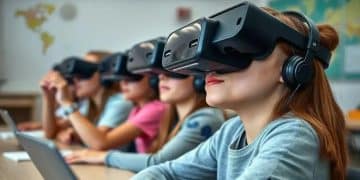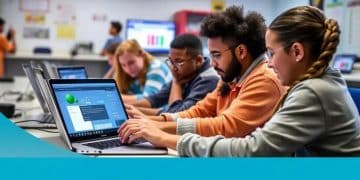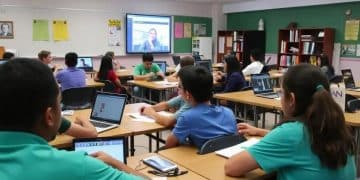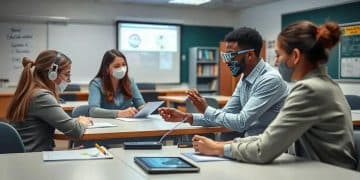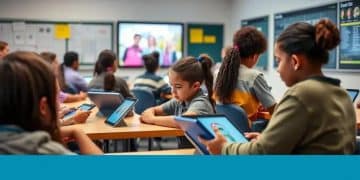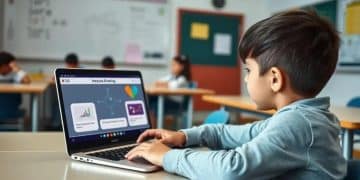Remote learning platforms trends to watch in 2024
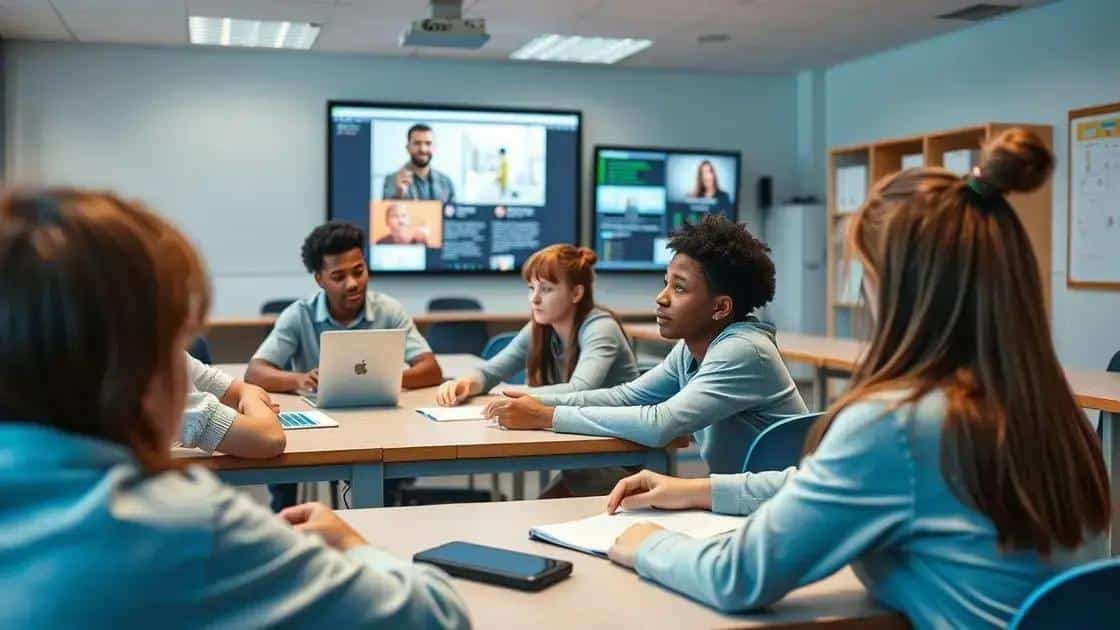
Future predictions for online education include personalized learning experiences, increased access through technology, immersive tools like virtual reality, and a focus on collaboration to enhance student engagement.
Remote learning platforms trends are evolving rapidly, influencing how we access education today. Have you noticed the changing dynamics of online learning? In this article, we will explore the latest trends that are set to reshape the educational landscape.
Emerging technologies in remote learning
As we look into emerging technologies in remote learning, it’s clear that the education landscape is evolving. Innovative tools are reshaping how educators and students interact. Are you curious about what these technologies entail?
Interactive Tools
One prominent aspect of remote learning is the rise of interactive tools. These tools engage students in new and exciting ways, making learning more enjoyable and effective. For instance, platforms that integrate virtual reality (VR) provide immersive experiences that can enhance understanding and retention of material.
- Virtual reality environments for immersive learning
- Gamification elements that enhance engagement
- Real-time feedback systems for students
Artificial Intelligence
Artificial intelligence is another key player in the realm of online education. AI applications can personalize learning experiences by adapting content to meet individual student needs. Imagine an AI tutor that provides tailored resources and responds to questions in real-time.
Additionally, AI tools can assist educators in managing their workloads by automating administrative tasks, allowing them to focus more on teaching. The integration of AI is a game-changer for improving both teaching and learning processes.
Mobile Learning Applications
Mobile learning applications are also becoming increasingly popular. These apps offer flexibility, allowing students to learn anytime and anywhere. With just a smartphone, students can access a wealth of resources, engage with peers, and participate in interactive lessons.
Such accessibility ensures that learners remain connected and engaged, irrespective of their physical location. This is particularly beneficial for students balancing multiple responsibilities.
In conclusion, staying updated with emerging technologies in remote learning is essential for educators and students alike. These innovations do not only enhance educational experiences but also prepare students for a tech-driven future.
Key features of successful platforms
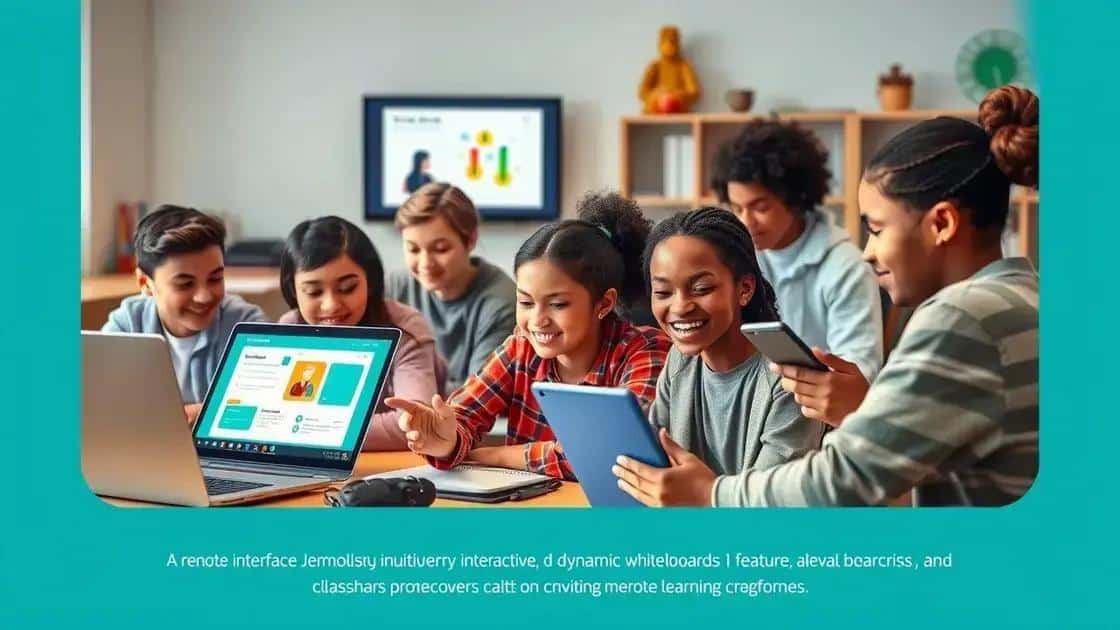
Understanding the key features of successful remote learning platforms is crucial for both educators and students. These platforms must provide an engaging learning experience that meets the needs of all users. So, what exactly makes a platform stand out?
User-Friendly Interface
One of the most important aspects is a user-friendly interface. Students and teachers alike need to navigate the platform with ease. A simple and intuitive design helps users focus on learning rather than struggling with technicalities.
- Clear menu structure for easy access to resources
- Mobile compatibility for learning on the go
- Customizable dashboards for personalized experiences
Interactive Learning Tools
Another vital feature is the availability of interactive learning tools. These tools can enhance engagement and help students retain information better. For example, incorporating quizzes, discussion boards, and multimedia elements encourages participation.
Interactive elements facilitate communication not just between students and educators, but also among peers. This collaboration often leads to a more enriching educational experience.
Robust Support System
A strong support system is essential for any learning platform. A well-equipped help center ensures that users can find answers to their questions promptly. Additionally, having a responsive support team can greatly enhance user satisfaction.
Assessment and Feedback Features
Lastly, effective assessment and feedback features are key to monitoring progress. Successful platforms offer tools for quizzes, assignments, and timely feedback. These elements allow educators to track student performance and provide tailored guidance.
Ultimately, when a remote learning platform effectively combines these key features, it not only enhances the learning experience but also fosters a supportive and efficient environment for all users.
Challenges faced by remote learning providers
Remote learning providers face several challenges in delivering quality education. Understanding these issues is important for improving the online learning experience for both teachers and students. What obstacles are they encountering?
Technological Limitations
One significant challenge is the technological limitations that many educational institutions encounter. While some have access to advanced tools, others struggle with outdated software and hardware. This inconsistency can hinder effective teaching and learning.
- Insufficient internet bandwidth for live classes
- Lack of access to devices for all students
- Compatibility issues with different platforms
Engagement and Motivation
An equally important issue is maintaining engagement and motivation among students. Online learning can feel isolating, which makes it difficult for students to stay focused. To address this, educators must find creative ways to connect with their students.
Using interactive content and fostering a sense of community can greatly enhance student involvement. For instance, group projects or discussion forums can help create connections.
Assessment Challenges
Assessment challenges also pose a problem for remote learning providers. Traditional testing methods may not be suitable for online settings, raising concerns about academic integrity. Finding fair and effective ways to evaluate student progress can be complex.
Supporting Diverse Learning Needs
Moreover, remote learning platforms must support diverse learning needs. Students have varying backgrounds and abilities, and a one-size-fits-all approach does not work. Adaptable learning materials and personalized support are essential for success.
As remote learning continues to evolve, recognizing and addressing these challenges will be key to providing a high-quality educational experience. Innovative solutions and ongoing support for both educators and students can help navigate these obstacles effectively.
Future predictions for online education
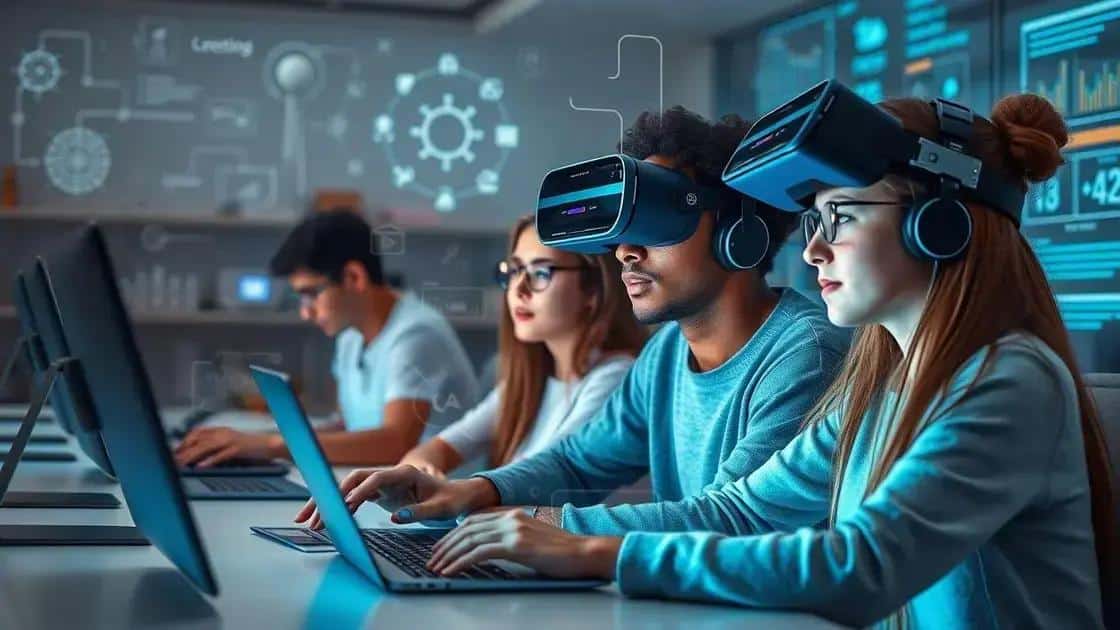
Future predictions for online education indicate that the landscape will continue to evolve dramatically. As technology advances, students and educators can expect exciting changes that will enhance the learning experience.
Increased Personalization
One significant trend is the increased personalization of learning paths. With the help of artificial intelligence, platforms will tailor educational content to meet individual student needs. Adaptive learning technologies can identify strengths and weaknesses, allowing for customized curricula.
- Individual learning plans based on assessments
- AI tools providing instant feedback
- Curated resources for specific learning styles
Greater Flexibility and Access
An essential aspect of future online education is greater flexibility and access. Students will have more options to learn at their own pace, whether through asynchronous or synchronous classes. This shift encourages a more balanced approach to education, accommodating various schedules and commitments.
Additionally, online education will continue to expand globally, providing opportunities for learners in remote areas. Greater access to quality resources will help bridge the educational divide.
Integration of Virtual and Augmented Reality
Another prediction is the integration of virtual and augmented reality into online learning environments. These technologies will create immersive experiences that enhance understanding and retention of complex subjects.
Imagine exploring ancient civilizations through virtual tours or conducting science experiments in a simulated environment. These innovative approaches can make learning more engaging and memorable.
Collaboration and Social Learning
Finally, future online education will emphasize collaboration and social learning. Platforms will focus on connecting students through group projects and peer-to-peer interactions, fostering a sense of community.
Asynchronous forums and real-time video discussions will help create a supportive learning environment, ensuring that students feel engaged and motivated. Together, these factors will shape a more effective and dynamic online education landscape.
In conclusion, the future of online education is filled with potential and excitement. As we see advancements in technology, personalized learning experiences, and the integration of immersive tools like virtual reality, students and educators alike will benefit greatly. Flexibility and accessibility will allow learners from all backgrounds to engage and thrive. By embracing collaboration and social learning, the educational landscape will become richer and more inclusive, creating a supportive environment for all.
FAQ – Frequently Asked Questions about Online Education
What is the future of online education?
The future of online education includes personalized learning, greater access to resources, and innovative tools like virtual reality.
How can technology improve student engagement?
Technology can enhance engagement through interactive tools, gamification, and by providing instant feedback.
What challenges do online learning platforms face?
Online learning platforms face challenges such as technological limitations, maintaining student motivation, and supporting diverse learning needs.
Why is collaboration important in online education?
Collaboration fosters a sense of community, encourages peer learning, and helps students feel more connected in a virtual environment.

